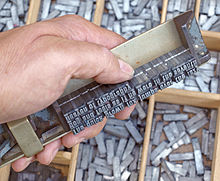Handset
The hand set is the oldest method for the production of printing forms with movable and single letters in the lead set for the printing process printing ( high pressure method ). Johannes Gutenberg further developed the process around 1440 and introduced it in Europe.
The lead letters are sorted into compartments in a type case . The typesetter takes the individual letters and the empty space ( "Spatien" ) and places them in an angle hook so that a line of text is created. The angle hook is set to the required line width beforehand. Several lines are dug out of the corner and hooks on a galley to set columns ( columns together). The ready-to-print set parts are tied for storage until the printing form is made , that is, tied together with a piece of column cord so that it is possible to lift this set without it falling apart. This requires a certain dexterity. In order for the shape to hold together, it requires a neatly closed set . This means that the individual lines have the same width and are excluded . If this is not observed, individual letters or blank material can come loose and fall out of the form during later printing or get into the printing machine. In the printing press, the pages are shot out and fixed in a steel frame with what is known as a locking device (the untying cord has been removed). Imposition means positioning the set in the printing press so that the printed sheet is correctly folded and results in the numbered sequence of the page sequence.
In hand typesetting, you cannot just type text alone. The formula set , for example, is very important . With brass lines and ornaments , graphic designs can be realized. Angled or round set is possible with complicated tension within the set with blank material. A heyday of these designs was at the end of the 19th / beginning of the 20th century. An attempt was made to set maps by hand from prefabricated individual elements, while the notation was a specialist work.
From the end of the 19th century, hand typesetting was increasingly displaced by machine typesetting in the area of bulk typesetting (books, newspapers, magazines) (see Monotype , Linotype ) , in which entire lines of writing were cast in lead. From about the 1950s won here the phototypesetting in importance, in which the signature on a photo mask, a disk or a strip of writing negative is (see intertypes Photo Etter , Monophoto ) . In the exposure apparatus have been signs individually aligned and on photo paper or film exposed. In the commercial sector also came during this period Diatype -Fotosatzgerät on the market.
Phototypesetting developed technically, but reached the limits of mechanical feasibility. From the mid-1980s onwards it faced strong competition from digital typesetting (see also sentence calculator , desktop publishing ) , which ousted it in the 1990s.
Manual typesetting in its original form of manual lead typesetting is still occasionally used in the production of bibliophile book editions and in small private and museum print shops.
See also
- Manuscript holder , consisting of tenacle and divisorium
literature
- Fritz Genzmer: The typesetter's book. 9th edition. Ullstein Fachverlag, Berlin 1967.


